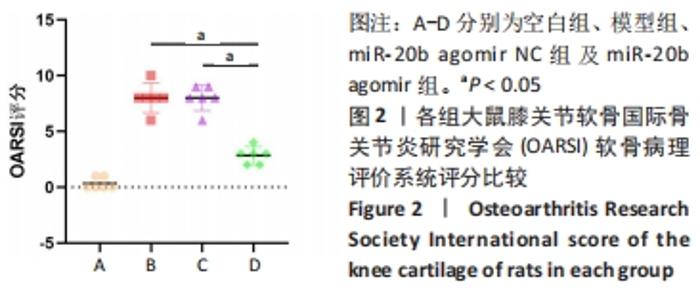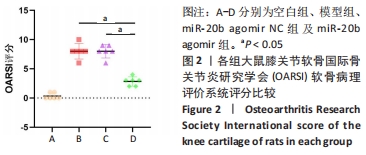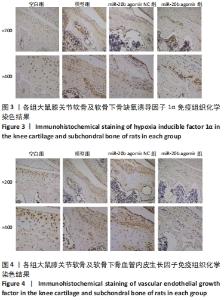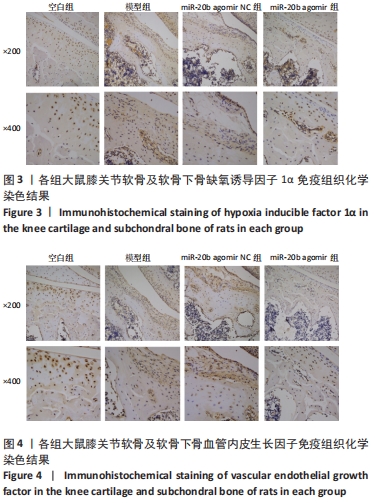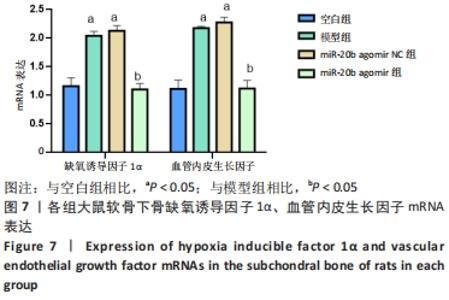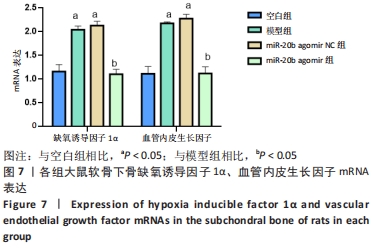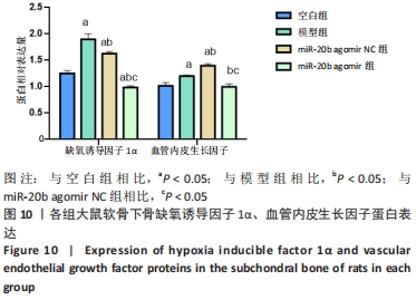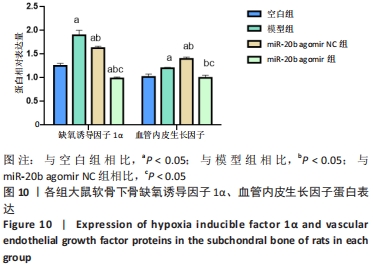Chinese Journal of Tissue Engineering Research ›› 2022, Vol. 26 ›› Issue (29): 4658-4665.doi: 10.12307/2022.852
Previous Articles Next Articles
MicroRNA-20b-5p effects on cartilage and subchondral bone angiogenesis in early-stage osteoarthritis rats
Lu Qigui1, Xie Pingjin1, Luo Zhen2, 3, Li Feilong2, Chen Qunqun2, Chai Shengting2
- 1Shenzhen Hospital, Shanghai University of Traditional Chinese Medicine/Shenzhen Luohu District Hospital of Traditional Chinese Medicine, Shenzhen 518000, Guangdong Province, China; 2Guangzhou University of Chinese Medicine, Guangzhou 510006, Guangdong Province, China; 3The Research Center of Basic Integrative Medicine, Guangzhou University of Chinese Medicine, Guangzhou 510006, Guangdong Province, China
-
Received:2021-03-27Accepted:2021-05-09Online:2022-10-18Published:2022-03-27 -
Contact:Xie Pingjin, Master, Physician, Shenzhen Hospital, Shanghai University of Traditional Chinese Medicine/Shenzhen Luohu District Hospital of Traditional Chinese Medicine, Shenzhen 518000, Guangdong Province, China -
About author:Lu Qigui, Chief physician, Shenzhen Hospital, Shanghai University of Traditional Chinese Medicine/Shenzhen Luohu District Hospital of Traditional Chinese Medicine, Shenzhen 518000, Guangdong Province, China -
Supported by:2020 Basic Research Project of Shenzhen Municipal Science and Technology Innovation Commission, No. JCYJ20190812170815559 (to LQG); Guangdong Provincial Administration of Traditional Chinese Medicine Research Project, No. 20202085 (to LFL); PhD Startup Collaboration Project of Guangdong Provincial Natural Science Foundation, No. 2018A030310606 (to CQQ)
CLC Number:
Cite this article
Lu Qigui, Xie Pingjin, Luo Zhen, Li Feilong, Chen Qunqun, Chai Shengting. MicroRNA-20b-5p effects on cartilage and subchondral bone angiogenesis in early-stage osteoarthritis rats[J]. Chinese Journal of Tissue Engineering Research, 2022, 26(29): 4658-4665.
share this article
Add to citation manager EndNote|Reference Manager|ProCite|BibTeX|RefWorks
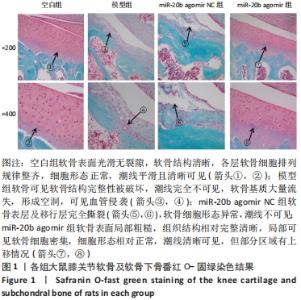
2.1 实验动物数量分析 实验共纳入SD大鼠12只,分为4组,实验过程无动物死亡,全部进入结果分析。 2.2 软骨及软骨下骨组织学观察及OARSI评分 病理切片见图1,空白组软骨表面光滑无裂隙,软骨结构清晰,各层软骨细胞排列规律整齐,细胞形态正常,潮线平滑且清晰可见(箭头①,②),软骨基质染色均匀,软骨下骨未见大量明显血管生成;模型组软骨可见软骨结构完整性被破坏,潮线完全不可见,软骨基质大量流失,形成空洞,可见血管侵袭(箭头③,④);miR-20b agomir NC组软骨表层及移行层完全撕裂(箭头⑤,⑥),软骨细胞形态异常,潮线不可见,软骨基质流失严重;miR-20b agomir组软骨表面局部粗糙,组织结构相对完整清晰,局部可见软骨细胞密集,细胞形态相对正常,潮线清晰可见,但部分区域有上移情况(箭头⑦,⑧),显示钙化层有所增厚,软骨基质染色相比空白组减轻但优于模型组及miR-20b agomir NC组,软骨及软骨下骨接近软骨钙化层区域未见过多小型血管。"
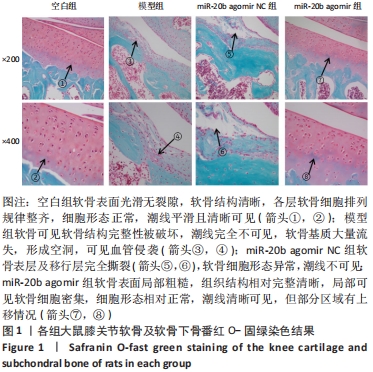
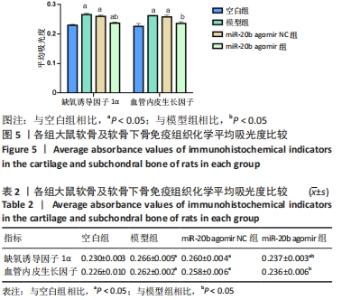
软骨及软骨下骨的HIF-1α免疫组化切片中,相较于空白组,模型组、miR-20b agomir NC组和miR-20b agomir组的平均吸光度更高(P < 0.001,P < 0.001,P=0.044),表达程度更高,差异有显著性意义;而相对于模型组和miR-20b agomir NC组,miR-20b agomir组的平均吸光度较低,差异有显著性意义(P < 0.001,P < 0.001)。 软骨及软骨下骨的VEGF免疫组化切片中,模型组、miR-20b agomir NC组的平均吸光度均高于空白组(P < 0.001,P < 0.001)和miR-20b agomir组(P < 0.001,P < 0.001),差异有显著性意义;而空白组与miR-20b agomir组之间的平均吸光度相比差异无显著性意义(P > 0.05);模型组与miR-20b agomir NC组之间的HIF-1α、VEGF免疫组化平均吸光度相比差异均无显著性意义(P > 0.05),见图5及表2。"
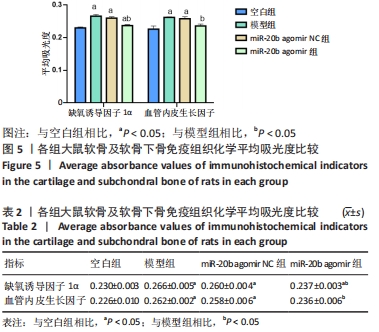
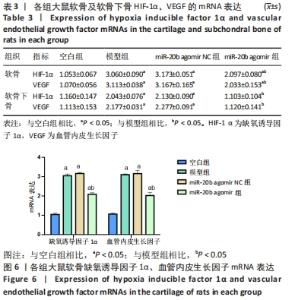
2.4 HIF-1α及VEGF mRNA表达 软骨中,模型组、miR-20b agomir组、miR-20b agomir NC组的HIF-1α及VEGF mRNA表达水平均高于空白组(P < 0.001,P < 0.001,P < 0.001,P < 0.001,P < 0.001,P < 0.001),差异有显著性意义。miR-20b agomir组的HIF-1α及VEGF mRNA表达水平低于模型组(P < 0.001,P < 0.001)和miR-20b agomir NC组(P < 0.001,P < 0.001),而模型组和miR-20b agomir NC组之间的表达水平差异无显著性意义(P > 0.05),见表3及图6。"
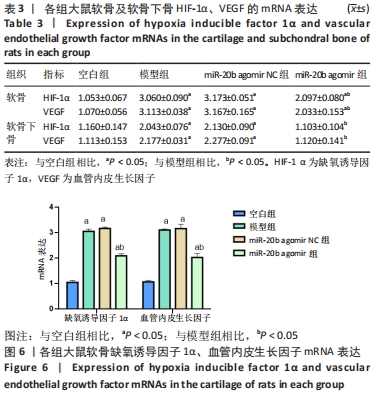
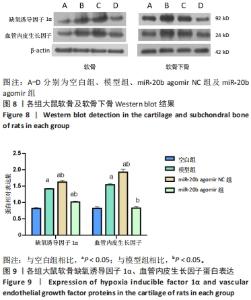
2.5 HIF-1α及VEGF 蛋白表达 软骨中,模型组、miR-20b agomir组、miR-20b agomir NC组的HIF-1α蛋白表达水平均高于空白组(P < 0.001,P < 0.001,P < 0.001),HIF-1α表达由低到高分别为miR-20b agomir组、模型组、miR-20b agomir NC组(P < 0.001,P < 0.001,P < 0.001),差异有显著性意义。模型组、miR-20b agomir NC组的VEGF蛋白表达水平均高于空白组(P < 0.001,P < 0.001),差异有显著性意义;而miR-20b agomir组与空白组的VEGF蛋白表达水平相比差异无显著性意义(P > 0.05),见图8,9。"
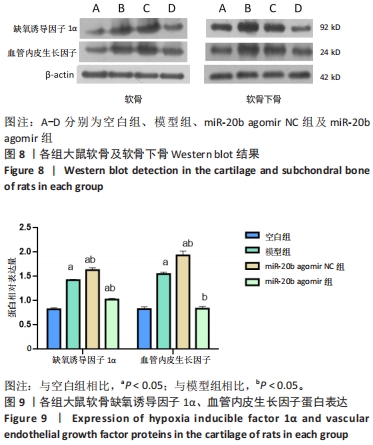
| [1] VON KAEPPLER EP, WANG Q, RAGHU H, et al. Interleukin 4 promotes anti-inflammatory macrophages that clear cartilage debris and inhibits osteoclast development to protect against osteoarthritis. Clin Immunol. 2021;229:108784. [2] IMHOF H, BREITENSEHER M, KAINBERGER F, et al. Degenerative joint disease: cartilage or vascular disease? Skeletal Radiol. 1997;26(7):398-403. [3] FRÖHLICH LF. Micrornas at the Interface between Osteogenesis and Angiogenesis as Targets for Bone Regeneration. Cells. 2019;8(2):121. [4] PUGH CW, RATCLIFFE PJ. Regulation of angiogenesis by hypoxia: role of the HIF system. Nat Med. 2003;9(6):677-684. [5] LIU M, WANG D, LI N. MicroRNA-20b Downregulates HIF-1α and Inhibits the Proliferation and Invasion of Osteosarcoma Cells. Oncol Res. 2016;23(5):257-266. [6] 谢平金,余翔,柴生颋,等.川芎嗪干预早期膝骨关节炎大鼠软骨Ⅱ型胶原纤维α1基因与血管内皮生长因子mRNA及miR20b的表达[J].中国组织工程研究,2018,22(12):1846-1851. [7] 李飞龙,谢平金,柴生颋,等.川芎嗪对膝骨性关节炎大鼠软骨VEGF表达的影响[J].中国骨质疏松杂志,2018,24(7):904-909. [8] 罗臻,李宏栩,卢启贵,等.红姜提取物保护早期膝骨关节炎模型大鼠的关节软骨[J].中国组织工程研究,2021,25(32):5155-5161. [9] PRITZKER KP, GAY S, JIMENEZ SA, et al. Osteoarthritis cartilage histopathology: grading and staging. Osteoarthritis Cartilage. 2006; 14(1):13-29. [10] LITWIC A, EDWARDS MH, DENNISON EM, et al. Epidemiology and burden of osteoarthritis. Br Med Bull. 2013;105:185-199. [11] SAFIRI S, KOLAHI AA, SMITH E, et al. Global, regional and national burden of osteoarthritis 1990-2017: a systematic analysis of the Global Burden of Disease Study 2017. Ann Rheum Dis. 2020;79(6):819-828. [12] WALSH DA. Angiogenesis and arthritis. Rheumatology (Oxford). 1999; 38(2):103-112. [13] BURR DB, GALLANT MA. Bone remodelling in osteoarthritis. Nat Rev Rheumatol. 2012;8(11):665-673. [14] PAN J, ZHOU X, LI W, et al. In situ measurement of transport between subchondral bone and articular cartilage. J Orthop Res. 2009;27(10): 1347-1352. [15] ZANETTI M, BRUDER E, ROMERO J, et al. Bone marrow edema pattern in osteoarthritic knees: correlation between MR imaging and histologic findings. Radiology. 2000;215(3):835-840. [16] HAWIGHORST H, LIBICHER M, KNOPP MV, et al. Evaluation of angiogenesis and perfusion of bone marrow lesions: role of semiquantitative and quantitative dynamic MRI. J Magn Reson Imaging. 1999;10(3):286-294. [17] MAPP PI, WALSH DA. Mechanisms and targets of angiogenesis and nerve growth in osteoarthritis. Nat Rev Rheumatol. 2012;8(7):390-398. [18] SU W, LIU G, LIU X, et al. Angiogenesis stimulated by elevated PDGF-BB in subchondral bone contributes to osteoarthritis development. JCI Insight. 2020;5(8):e135446. [19] MA L, ZHAO X, LIU Y, et al. Dihydroartemisinin attenuates osteoarthritis by inhibiting abnormal bone remodeling and angiogenesis in subchondral bone. Int J Mol Med. 2021;47(3):04855. [20] HENROTIN Y, PESESSE L, LAMBERT C. Targeting the synovial angiogenesis as a novel treatment approach to osteoarthritis. Ther Adv Musculoskelet Dis. 2014;6(1):20-34. [21] PATIL AS, SABLE RB, KOTHARI RM. Occurrence, biochemical profile of vascular endothelial growth factor (VEGF) isoforms and their functions in endochondral ossification. J Cell Physiol. 2012;227(4):1298-1308. [22] HU K, OLSEN BR. Osteoblast-derived VEGF regulates osteoblast differentiation and bone formation during bone repair. J Clin Invest. 2016;126(2):509-526. [23] HAMILTON JL, NAGAO M, LEVINE BR, et al. Targeting VEGF and Its Receptors for the Treatment of Osteoarthritis and Associated Pain. J Bone Miner Res. 2016;31(5):911-924. [24] WALSH DA, BONNET CS, TURNER EL, et al. Angiogenesis in the synovium and at the osteochondral junction in osteoarthritis. Osteoarthritis Cartilage. 2007;15(7):743-751. [25] BARRANCO C. Osteoarthritis: Animal data show VEGF blocker inhibits post-traumatic OA. Nat Rev Rheumatol. 2014;10(11):638. [26] GIATROMANOLAKI A, SIVRIDIS E, MALTEZOS E, et al. Upregulated hypoxia inducible factor-1alpha and -2alpha pathway in rheumatoid arthritis and osteoarthritis. Arthritis Res Ther. 2003;5(4):R193-201. [27] KATOH M. Therapeutics targeting angiogenesis: genetics and epigenetics, extracellular miRNAs and signaling networks (Review). Int J Mol Med. 2013;32(4):763-767. [28] PRASADAM I, BATRA J, PERRY S, et al. Systematic identification, characterization and target gene analysis of microRNAs involved in osteoarthritis subchondral bone pathogenesis. Calcif Tissue Int. 2016; 99(1):43-55. [29] BORGONIO CUADRA VM, GONZALEZ-HUERTA NC, ROMERO-CORDOBA S, et al. Altered expression of circulating microRNA in plasma of patients with primary osteoarthritis and in silico analysis of their pathways. PLoS One. 2014;9(6):e97690. [30] CHEN Y, ZHANG L, LI E, et al. Long-chain non-coding RNA HOTAIR promotes the progression of osteoarthritis via sponging miR-20b/PTEN axis. Life Sci. 2020;253:117685. [30] QIN B, LIU J, LIU S, et al. MiR-20b targets AKT3 and modulates vascular endothelial growth factor-mediated changes in diabetic retinopathy. Acta Biochim Biophys Sin (Shanghai). 2016;48(8):732-740. [32] 马玉峰,祁印泽,王庆甫,等.关节内注射药物建立骨性关节炎动物模型研究进展[J].中国骨伤,2015,28(1):90-95. [33] JONES IA, TOGASHI R, WILSON ML, et al. Intra-articular treatment options for knee osteoarthritis. Nat Rev Rheumatol. 2019;15(2):77-90. [34] WANG H, ZHANG H, SUN Q, et al. Intra-articular Delivery of Antago-miR-483-5p Inhibits Osteoarthritis by Modulating Matrilin 3 and Tissue Inhibitor of Metalloproteinase 2. Mol Ther. 2017;25(3):715-727. |
| [1] | Wang Baojuan, Zheng Shuguang, Zhang Qi, Li Tianyang. Miao medicine fumigation can delay extracellular matrix destruction in a rabbit model of knee osteoarthritis [J]. Chinese Journal of Tissue Engineering Research, 2022, 26(8): 1180-1186. |
| [2] | Wang Qin, Shen Cheng, Liao Jing, Yang Ye. Dapagliflozin improves renal injury in diabetic nephropathy rats [J]. Chinese Journal of Tissue Engineering Research, 2022, 26(8): 1216-1222. |
| [3] | Hou Jingying, Guo Tianzhu, Yu Menglei, Long Huibao, Wu Hao. Hypoxia preconditioning targets and downregulates miR-195 and promotes bone marrow mesenchymal stem cell survival and pro-angiogenic potential by activating MALAT1 [J]. Chinese Journal of Tissue Engineering Research, 2022, 26(7): 1005-1011. |
| [4] | Zhao Dun, Fang Bin, Yi Chunzhi, He Mincong, Zheng Jiaqian, Li Yue. Effects of total flavonoids of Rhizoma drynariae on bone remodeling and expression of bone morphogenetic protein-2, vascular endothelial growth factor and CD31 [J]. Chinese Journal of Tissue Engineering Research, 2022, 26(29): 4638-4642. |
| [5] | Zhu Boheng, Peng Ying, Wang Hong. Mechanism and application of sterol regulatory element binding protein in wound healing [J]. Chinese Journal of Tissue Engineering Research, 2022, 26(29): 4729-4734. |
| [6] | Wu Yuchong, Peng Xu, Yu Xixun. Osteogenesis, angiogenesis and anti-aseptic loosening of europium-doped calcium polyphosphate bone tissue engineering scaffold [J]. Chinese Journal of Tissue Engineering Research, 2022, 26(28): 4458-4465. |
| [7] | Zhao Doudou, Lin Kaili. Application of multicellular construction of vascularized tissue engineered bone in bone repair [J]. Chinese Journal of Tissue Engineering Research, 2022, 26(27): 4386-4392. |
| [8] | Yu Xiaofan, Jiang Huijiao, Tan Xiaowu, Wu Xiangwei. Expression of vasohibin-1 and other factors after the co-culture of two kinds of Echinococcus granulosus protoscolex and endothelial progenitor cells [J]. Chinese Journal of Tissue Engineering Research, 2022, 26(24): 3892-3896. |
| [9] | Chen Na, Wang Xiaohan, Zhang Yunke. Effect and mechanism of mesenchymal stem cells on aging-related ischemic stroke [J]. Chinese Journal of Tissue Engineering Research, 2022, 26(24): 3914-3920. |
| [10] | Li Duchenhui, Tian Ai, Tang Zhenglong. Angiogenesis induced by bone bioscaffold materials [J]. Chinese Journal of Tissue Engineering Research, 2022, 26(22): 3602-3608. |
| [11] | Zhang Chunyu, Hu Baoyang, Feng Yao, Zhang Wanfen, Sun Leiye, Yang Yan. Performance optimization of a new type of calcium silicate (based) scaffold matched with bone tissue regeneration in the bone defect area [J]. Chinese Journal of Tissue Engineering Research, 2022, 26(21): 3421-3428. |
| [12] | Wang Weiwei, Ou Zhixue, Zhang Xiaoyun, Li Shibin, Zhou Yi, Li Tong. Regulatory mechanism of exosomes in signal communication network of steroid induced avascular necrosis of the femoral head repair [J]. Chinese Journal of Tissue Engineering Research, 2022, 26(19): 3056-3064. |
| [13] | Peng Huizhen, Cai Mingxiang, Liu Xiangning. Angiogenesis regulation in bone repair: new ideas and new methods [J]. Chinese Journal of Tissue Engineering Research, 2022, 26(15): 2400-2405. |
| [14] | Chen Na, Fan Feiyan, Li Shuangli, Zhang Yunke. Effect and mechanism of traditional Chinese medicine regulating mesenchymal stem cell-derived exocrine for ischemic stroke [J]. Chinese Journal of Tissue Engineering Research, 2022, 26(13): 2081-2086. |
| [15] | Luo Di, Liang Xuezhen, Liu Jinbao, Li Jiacheng, Yan Bozhao, Xu Bo, Li Gang. Difference in osteogenesis- and angiogenesis-related protein expression in femoral head samples from patients with femoral head necrosis of different etiologies [J]. Chinese Journal of Tissue Engineering Research, 2022, 26(11): 1641-1647. |
| Viewed | ||||||
|
Full text |
|
|||||
|
Abstract |
|
|||||
